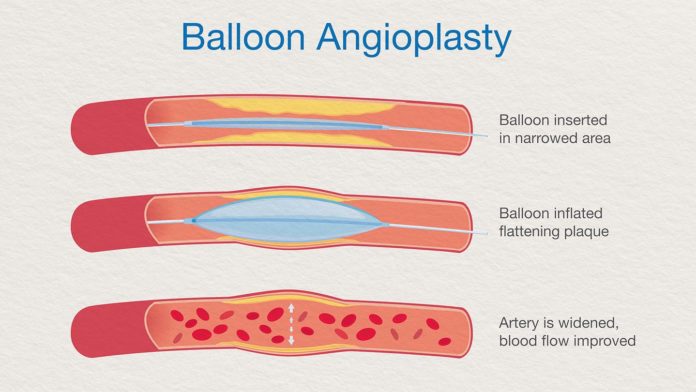Angioplasty is a minimally invasive procedure used to widen narrowed or blocked arteries.
Your arteries can become blocked up over time from deposits of plaque — the buildup of fat, cholesterol, cells, and other substances.
This condition is called atherosclerosis, and it can affect any artery in the body.
Why the Procedure Is Done
Angioplasty is often used to restore blood flow to the heart in people who have coronary arteries affected by atherosclerosis, a condition called coronary heart disease (CHD), or coronary artery disease.
Angioplasty may also be used to help with other issues, including:
- Atherosclerosis in the legs or arms, also known as peripheral artery disease, per Johns Hopkins Medicine
- Renal vascular hypertension, or high blood pressure caused by the narrowing of the kidney arteries, usually from atherosclerosis, per NYU Langone Health
- Carotid artery stenosis, in which the neck arteries supplying blood to the brain become narrowed; carotid angioplasty is often performed to prevent or treat strokes, per Mayo Clinic
Angioplasty Procedure
Before conducting an angioplasty, your doctor will need to locate the narrowed or blocked passages in your arteries through an angiogram.
During an angiogram, a small tube called a catheter will be inserted into an artery (usually in your groin or arm) and then threaded to the problematic area, such as the coronary arteries.
Next, during the angioplasty, a catheter with a balloon on its tip will be inserted and threaded to the blocked artery.
The balloon will be expanded to flatten the plaque against the artery wall and improve blood flow, and then deflated and removed.
Angioplasty Recovery
Angioplasty Risks
- Blood vessel damage and bleeding
- Allergic reactions or kidney damage from dye used during the procedure (especially if you already have kidney problems)
- Irregular heartbeat
- Heart attack
- Stroke (in rare cases)
- Artery collapse
- Angina
- Scar tissue and blood clots around stents
After an Angioplasty
- Stick to a heart-healthy diet low in saturated fat
- Quit smoking (if you haven’t already)
- Exercise regularly
- Reduce stress
Additional reporting by Deborah Shapiro.
Editorial Sources and Fact-Checking
- Coronary Angioplasty and Stents. Mayo Clinic. November 15, 2019.
- Renal Artery Stenosis in Adults. NYU Langone Health.
- Carotid Angioplasty and Stenting. Mayo Clinic. July 1, 2020.
- Angioplasty and Stent Placement — Heart. MedlinePlus. June 25, 2020.
- Coronary Angiography. MedlinePlus. January 27, 2020.
- Cardiac Catheterization and Coronary Angioplasty and Stent. Cleveland Clinic. May 14, 2019.
- Percutaneous Coronary Intervention. National Heart, Lung, and Blood Institute.
- Angioplasty. MedlinePlus. March 6, 2017.
- Percutaneous Transluminal Angioplasty. Johns Hopkins Medicine.













































